Ata-ul-Haye Nasir, Al Hakam
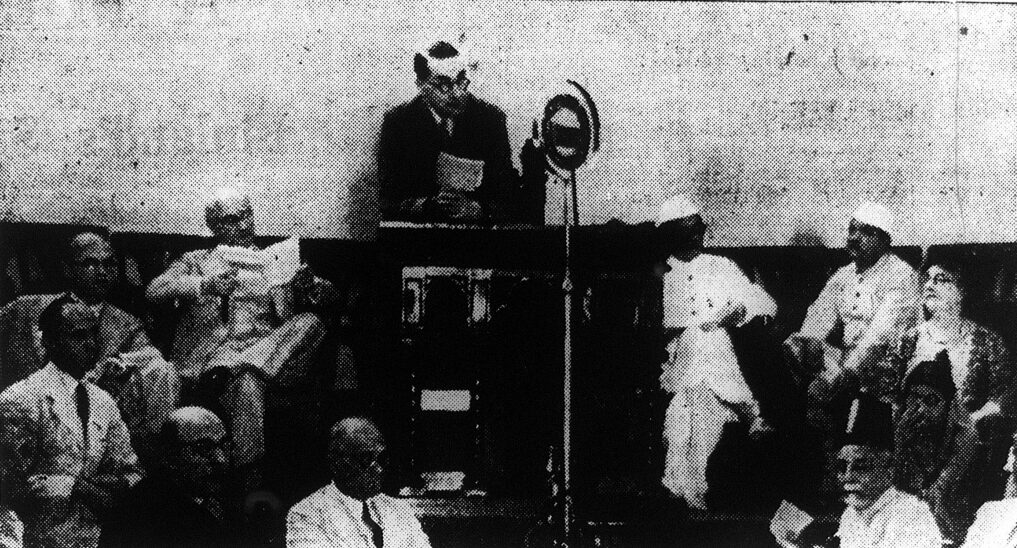
Introduction of Sir Maurice Gwyer
Sir Maurice Linford Gwyer, GCIE, KCB, KCSI, was born in 1878, and obtained his education at Westminster and at Christ Church, Oxford University. He was called to the bar in 1902, and took silk in 1930. From 1912 to 1915, he served as a lecturer in private international law at Oxford, and from 1912 to 1916, as solicitor to the Insurance Commissioners. After being a legal adviser to the Ministry of Shipping from 1917 to 1919, he held a similar post at the Ministry of Health from 1919 to 1926. His services in 1927-28 as a member of the Royal Commission on London Squares preceded his appointment in 1930 as the first British delegate to the Hague Codification of International Law, which was followed by his being selected as a member of the Indian States Inquiry in 1932. As Parliamentary Counsel to the Treasury, in 1933, he drafted the India Bill, which in 1935 became an Act, and on the basis of this, India and Pakistan became independent in 1947. Chosen in 1937 as the first Chief Justice of India and President of the Federal Court, he held these offices until his retirement in 1943, but remained in India until 1950 as Vice-Chancellor of the University of Delhi, to which he was first appointed in 1938. He was the editor of several recognised legal textbooks as well. He passed away on 12 October 1952. (Eastbourne Gazette, 15 October 1952, p. 11)
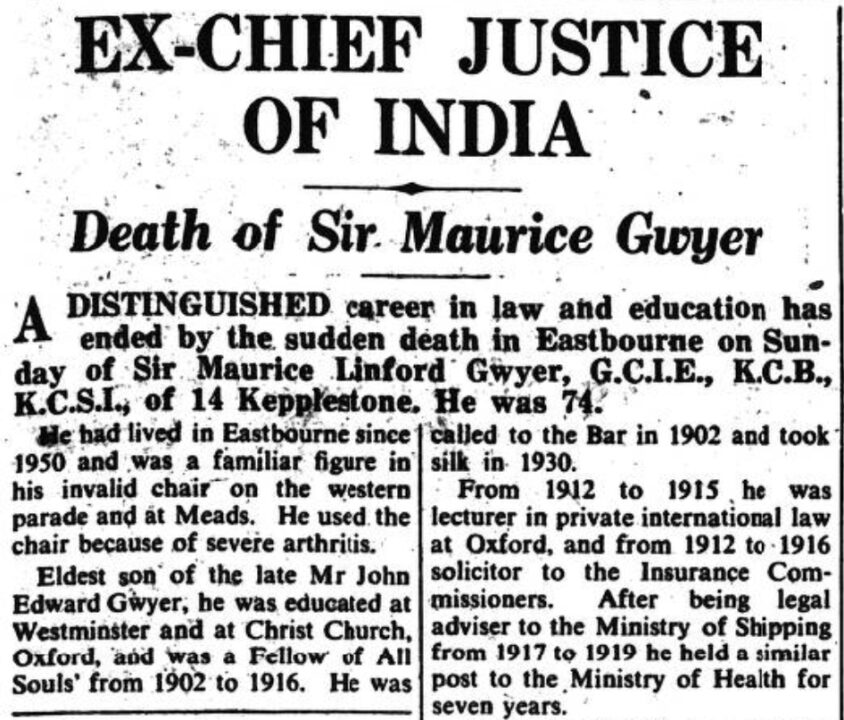
The Manchester Guardian wrote that Sir Maurice Gwyer “was one of the most notable persons of the last days of the British Raj in India.” (The Manchester Guardian, 14 October 1952, p. 6)
Visit to Qadian – First Day
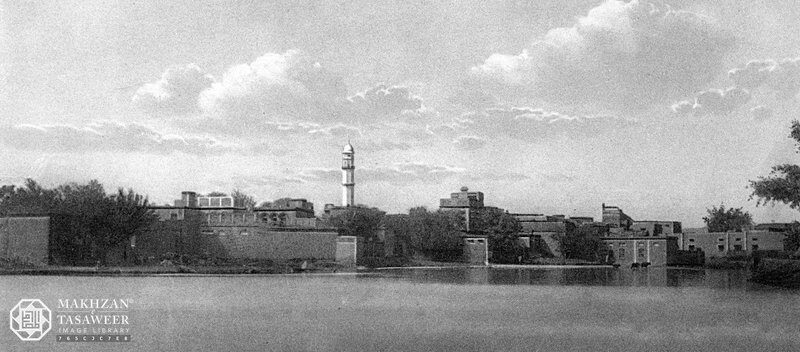
In April 1940, when he was serving as the Chief Justice of the Indian Federal Court, Sir Maurice Gwyer visited Qadian. He reached Qadian on 14 April at 9:30am, along with his son, Major John Gwyer. He was warmly received by Hazrat Chaudhry Sir Zafrulla Khanra, various Naziraan and other members of the Jamaat.
During his visit to Qadian, Sir Maurice visited various offices and institutions of the Ahmadiyya Muslim Community. He was welcomed at the Ahmadiyya Chowk [Ahmadiyya Square] by Chaudhry Fateh Muhammad Sahib, the then Nazir-e-Ala. He then visited the Madrasa-e-Ahmadiyya where he was welcomed by Hazrat Mir Muhammad Ishaqra, the then Headmaster of the Madrasa. The students and staff of the Madrasa were present in the courtyard. There were several foreign students as well, such as those from Sumatra, Java, Eastern Turkistan, Afghanistan, and East Africa. He also visited the boarding area of the Madrasa.
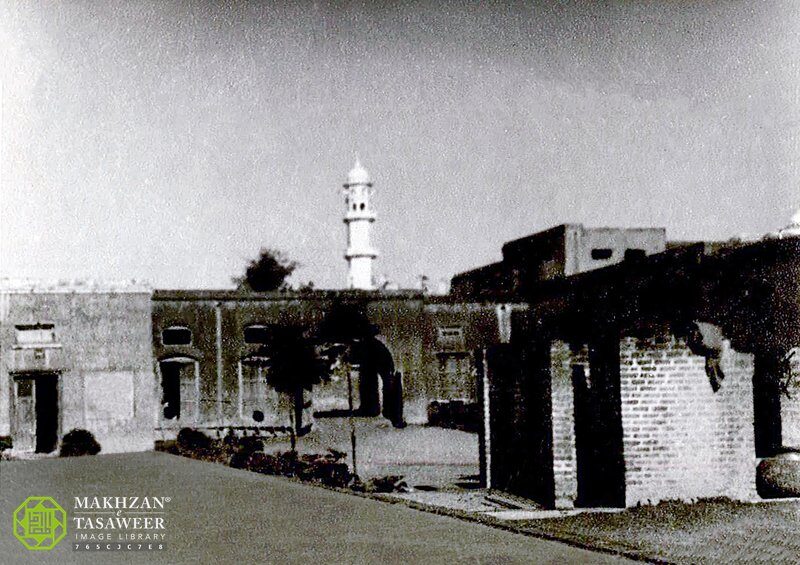
Sir Maurice then visited the office of Bait-ul-Maal, where he was informed about the financial system, i.e. chandajaat of the Jamaat. Following this, he was briefed about the institution of Majlis-e-Mushawarat and told about its purpose, importance, and procedures. Then, he visited the Qadha office, where he was welcomed by Mirza Abdul Haq Sahib.
After this, he went to the office of Bahishti Maqbarah, where Hazrat Maulvi Syed Sarwar Shahra welcomed him, followed by a visit to the Umur-e-Ama office, where the then Nazir Umur-e-Ama Hazrat Syed Zainul Abideen Waliullah Shahra greeted him, and Hazrat Chaudhry Zafrulla Khanra briefed Sir Maurice in regards to the responsibilities of this department. He then visited the office of Umur-e-Kharija, and was briefed about its duties.
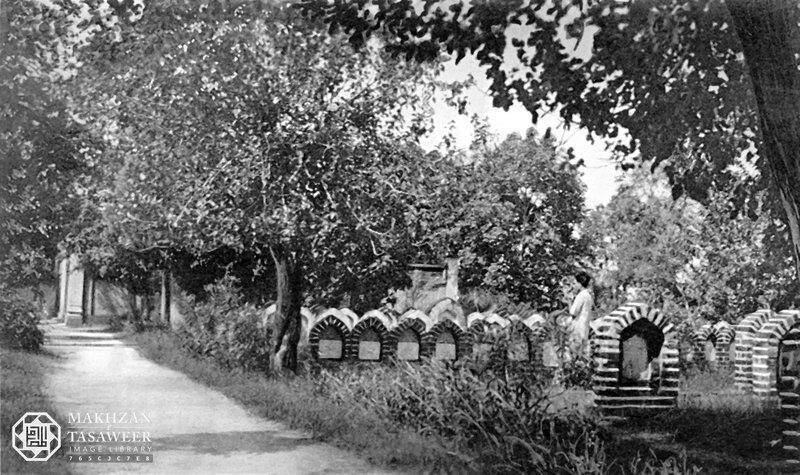
Following this, Sir Maurice visited the office of Nazir Talim-o-Tarbiyat, where he had a discussion with Hazrat Mirza Sharif Ahmadra who was serving as Nazir Talim-o-Tarbiyat. Hazrat Mirza Sharif Ahmadra briefed him about the educational institutes functioning under this nazarat.
He then visited the office of Nazir-e-Ala, from there he proceeded to the Aqsa Mosque, and then to the office of Private Secretary to Hazrat Khalifatul Masih IIra where he was informed about the busy schedule of Huzoorra. He was astonished upon learning that during the Jalsa days, in addition to his speeches, Huzoorra would grace thousands of attendees with musafaha, i.e., shake hands with them, and that Huzoorra would sleep for around two hours only.
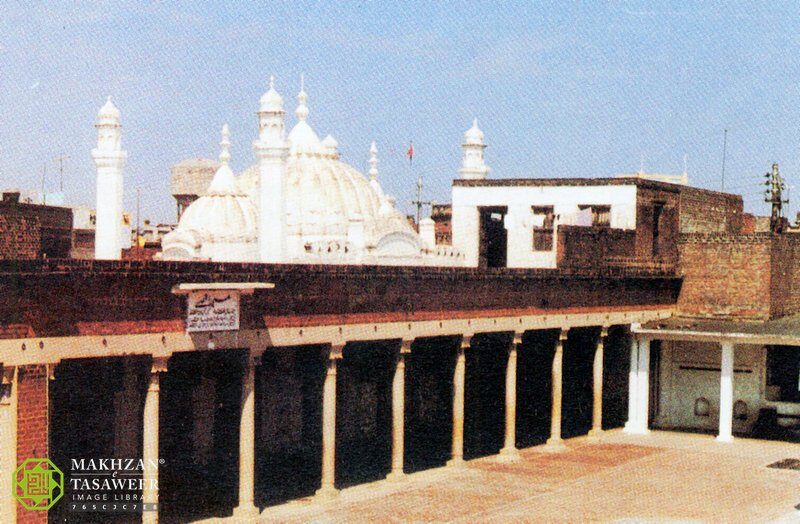
While he was proceeding towards the office of Da’wat-o-Tabligh, he was introduced to the Majlis Khuddam-ul-Ahmadiyya and particularly mentioned their passion for the service of mankind. After this, he moved to the office of Nashr-o-Ishaat, where he was gifted with some Jamaat literature. Hazrat Maulvi Abdur Rahim Nayyarra, while showing a map of the world, highlighted to him those places where Ahmadiyyat had reached at the time.
After this, Sir Maurice Gwyer went to the residence of Hazrat Sir Chaudhry Zafrulla Khanra. At lunch, the then Nazir-e-Ala Hazrat Chaudhry Fateh Muhammad Syalra, Hazrat Mufti Muhammad Sadiqra and the then Nazir Umur-e-Ama Hazrat Syed Zainul Abideen Waliullah Shahra were also invited. On that occasion, Sir Maurice was introduced in detail to the Ahmadiyya Muslim Community. (Al Fazl, 16 April 1940, pp. 1-2)
Sir Maurice meets with Hazrat Musleh-e-Maudra at the Tea Party

In the evening, Hazrat Sir Chaudhry Sahibra organised a tea party at his place, which was graced by the presence of Hazrat Musleh-e-Maudra, and Sir Maurice had the opportunity to meet and have a discussion with Huzoorra. (Ibid, p. 2)
The Times of India reported:
“The aims and objects of education were explained by Sir Maurice Gwayer, Chief Justice of India, addressing the students of the Talimul Islam High School, Qadian, on Monday. Sir Maurice had tea with Hazrat Mirza Bashiruddin Mahmud Ahmad, head of the Ahmadiyya community, at the residence of Sir Mahomed Zafrulla Khan.” (The Times of India, 17 April 1940, p. 3)
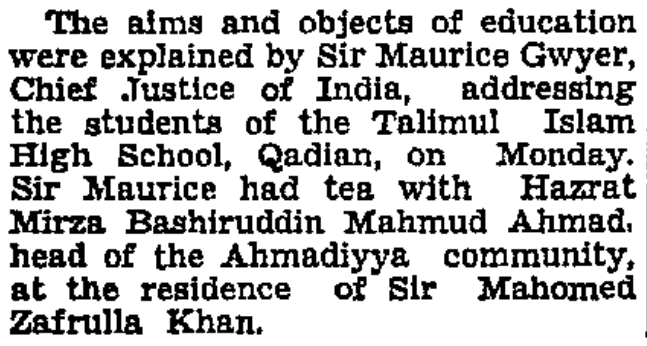
Second Day
On the next day, 15 April, at around 9:30am, Sir Maurice visited the MAC Works (Electric Appliances Factory), and was accompanied by Hazrat Sir Chaudhry Zafrulla Khanra, Hazrat Mirza Sharif Ahmadra, Mian Muhammad Ahmad Khan Sahib, and Mistri Muhammad Ismail Sahib Siddiqui. After seeing its functioning, he wrote a note in the visitor’s book as well.
After this, he proceeded to the Talim-ul-Islam High School, where he was to deliver a speech. The arrangement of loudspeakers was also available in the hall and around 250 people were in attendance. In addition to the students and staff of the senior classes of the High School, the students of the Girls High School were also present with the arrangement of purdah. Moreover, English-speaking members of the public were also present.
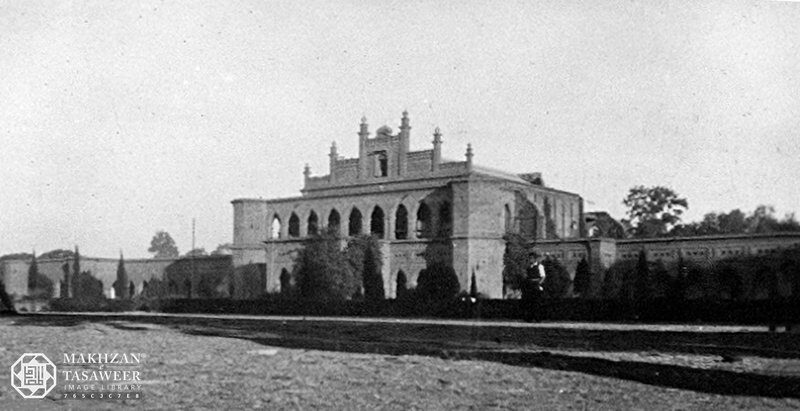
Speech of Hazrat Sir Chaudhry Zafrulla Khanra
In the beginning, Hazrat Sir Chaudhry Muhammad Zafrulla Khanra delivered a speech and said:
“Sir Maurice Gwyer, we are very pleased to welcome you to Qadian. Though this is the first time you have visited the markaz [headquarters] of Jamaat-e-Ahmadiyya, we hope that it will be the beginning of more such occasions. And when you visit here again, you will not come as a stranger, but rather, you will feel as if you are meeting your own brothers. […] It is possible that you may not agree with the objectives and aims for which Jamaat-e-Ahmadiyya is striving, however, as a result of your visit, you will go back with the impression that Jamaat-e-Ahmadiyya is striving for those objectives, which apparently seem very surprising.
“For instance, the first and foremost objective of the establishment of Jamaat-e-Ahmadiyya is to establish a strong connection between mankind and their Creator. Though it is difficult for me to present its details here, it is certain that we are striving for this objective with the certainty that its achievement is possible. We, who have gathered here [as a Jamaat] from different parts of the world, have firm faith that the establishment of the union between the Creator and His creation is as much possible as it was in the previous eras and its attainment is one of the foremost duties of Jamaat-e-Ahmadiyya.
“The second major objective that Jamaat-e-Ahmadiyya serves is to create unity between different people, races, and cultures. These endeavours of Jamaat-e-Ahmadiyya may seem very small, however, this strive is for an objective that is achievable for sure. Our main objective behind establishing factories here is not to make Qadian an industrial city, but rather, its purpose is to achieve that very objective, which is always in our eyes [i.e., service to humanity], since, Islam focuses on each and every aspect of a Muslim, whether it is spiritual, worldly, economic, or social.
“Our Jamaat holds a distinction in relation to the quest for these objectives, that is, we always advocate the utilisation of peaceful means to alleviate any flaws, whether they are related to the government or the public. Our principle is that the ruler shall get their due rights, and the rights of God shall be given to Him.” (Al Fazl, 17 April 1904, p. 1)
Speech by Sir Maurice Gwyer
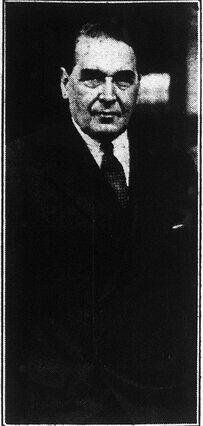
After this, Sir Maurice Gwyer delivered a speech:
“It is a source of great pleasure for me that I accepted the invitation of Sir Muhammad Zafrulla Khan to visit Qadian. I am afraid I have not made any preparations for any speech here, and thus, I will keep it very short. First of all, I will share my impressions of your Community that I have gained during this short stay. I have seen that the members of your Community are inspired by a burning faith and adhere to certain objectives and principles, and they desire to regulate their lives accordingly. Here, I have witnessed the extraordinary impact of the principle of equality between different people and nations. This principle of brotherhood between mankind is the fundamental principle of human life, and I have seen that the spirit of equality and brotherhood is found within your Community. For this reason, I believe that my principles are common to yours.” (Ibid, p. 2)
Revisiting the time when he was a student, Sir Maurice said that though the previous generation’s era as students was very different from the time of the current generation, the objectives of education are still the same, which must be kept in mind by the students.
Continuing his speech, he said:
“The foremost objective of obtaining an education is for the students to realise their obligation, which is incumbent upon them with respect to their connection with their Creator. It means that they should make their utmost efforts to fulfil the rights of God in their true essence. The second objective of education is to enable the students to utilise their God-gifted intellectual capabilities, and through them they not only serve their country, but rather, they deem it their duty to serve the whole of mankind.” (Ibid)
Further, he said that he was pleased to know that the literacy rate in Qadian is nearly 100 per cent. He added that he will leave Qadian with such impressions that will remain fresh in his heart for a very long time, and will always please his heart. At the end of his speech, he said to the audience, “as-salamu ‘alaikum”.
Concluding remarks by Hazrat Sir Chaudhry Zafrulla Khanra
After this, Hazrat Sir Chaudhry Zafrulla Khanra expressed his gratitude to the honourable Chief Justice of India, and hoped that he would visit Qadian again.
Visit of the school and other places
Following this, Sir Maurice Gwyer was given a brief tour of the school, and met with those students who had come here for education from far distances. He then visited the boarding house, where he was welcomed by the superintendent, Sufi Ghulam Muhammad Sahib, and was briefed about the students’ daily routine.
Then, he visited the dispensary of the boarding, where he was welcomed by the then incharge, Dr Muhammad Abdullah Sahib. Sir Maurice left comments in the school’s logbook as well.
Sir Maurice then visited the Himalaya Glass Works, where he was shown how the items were manufactured. He then proceeded to the Star Hosiery Works and saw it functioning.
Sir Maurice meets with Hazrat Musleh-e-Maudra at Lunch Reception
On the same day, Hazrat Sir Zafrulla Khanra gave lunch reception in honour of the guest, and the event was graced with the presence of Hazrat Musleh-e-Maudra. The other attendees included Hazrat Mirza Bashir Ahmadra, Khan Zulfiqar Ali Khan Sahib, and Hazrat Dr Mir Muhammad Ismailra. (Ibid)
He also visited the Noor Hospital, along with then Nazir Umur-e-Ama Hazrat Syed Zainul Abideen Waliullah Shahra, and was briefed about the hospital’s functioning by Dr Hashmatullah Khan Sahib. He signed the visitors book as well. (Al Fazl, 18 April 1940, p. 2)
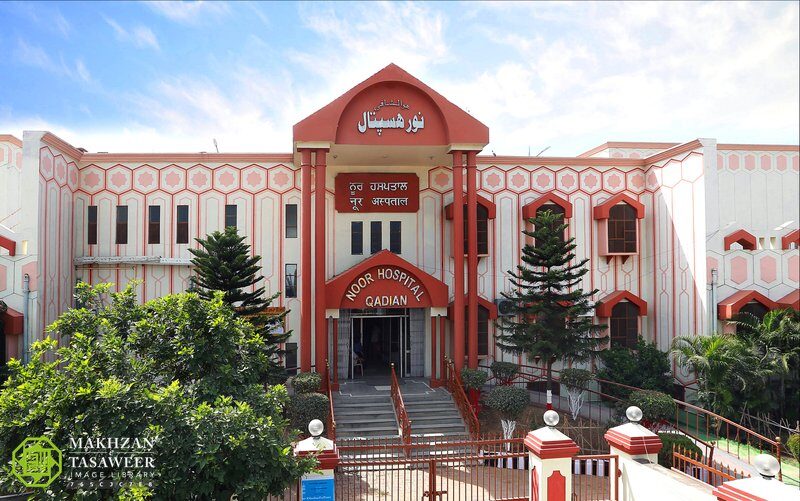
Third Day
On 16 April 1940, Sir Maurice departed from Qadian in a car along with his son, Major John Gwyer, at 10:30am. Hazrat Sir Zafrulla Khanra, Nazir-e-Ala Chaudhry Fateh Muhammad Sahib, other Naziran, and presidents of various mahallas, bid them farewell. (Ibid)
Reporting on this visit of the Chief Justice, The Civil and Military Gazette wrote:

“SIR MAURICE GWYER’S VISIT TO QADIAN
“Address on True Ideals of Education
“QADIAN, April 15.
“The true ideals of education were explained by Sir Maurice Gwyer, Chief Justice of India, addressing the students of the Talim-ul-Islam High School, Qadian.
“He said: First, education taught young men of their duty towards God and their fellowmen. Secondly, it enabled them to cultivate the talents that God had given them for the service not only to their own community and country but to the brotherhood of mankind. Thirdly, it not only enabled young people of this and succeeding generations to share the thoughts, writings and imagination of great men, who preceded them, but to become sharers of the immense literature, thought and beauty of the works they had produced and completed in their lifetime. He felt that in their works they had resources that would never fail them, however difficult the times might be.
“Speaking about his impressions of the Ahmadia community, Sir Maurice Gwyer said that during his brief stay here he had seen people inspired by a burning faith and adhering to principles by which they sought to regulate their lives.
“The fundamental principles of equality and brotherhood that formed the background of man’s life, he said, were beautifully acted upon by members of the community.
“‘I heard this morning from Sir Mahomed Zafrullah Khan, continued the Chief Justice, “that the percentage of literacy in this town is nearly 100 percent. I believe no other town in India has set so noble an example before us. We, who occupy the position of judges, cannot take an interest in matters outside our sphere, but a judge has, after all, to deal not only with questions of law but with human beings as well. He has to acquaint himself with the great currents of thought in the country where he is discharging his duties; otherwise, he cannot understand the men and women who are affected by them. Even though my duty as a judge lies within a limited sphere, it touches upon the ideals that lie outside that sphere. It is my privilege, or rather my duty, to become acquainted with the thoughts of people who have nothing to do with law. I rejoice at having acquainted myself with the people of this land. I rejoice to have accepted Sir Mahomed Zafrullah’s invitation and visited this community of which he is so proud.’
“Sir Maurice Gwyer had tea with Hazrat Mirza Bashir-ud-Din Ahmed, head of the Ahmadiyya community, at the residence of Sir Mahomed Zafrullah Khan.—A.P.” (The Civil and Military Gazette, 17 April 1940, p. 13)
The Indian Express of Madras published a similar news report under the heading “Duty Towards God and Fellowmen: True Aims & Objects of Education—Sir M. Gwyer’s Address”. (The Indian Express, 17 April 1940, p. 7)
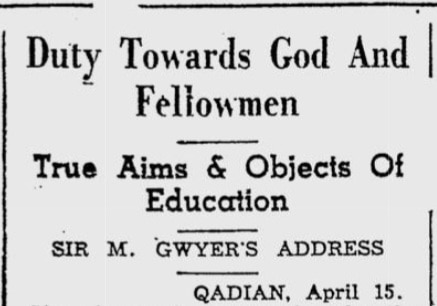


What an interesting and detailed account. JazakAllah